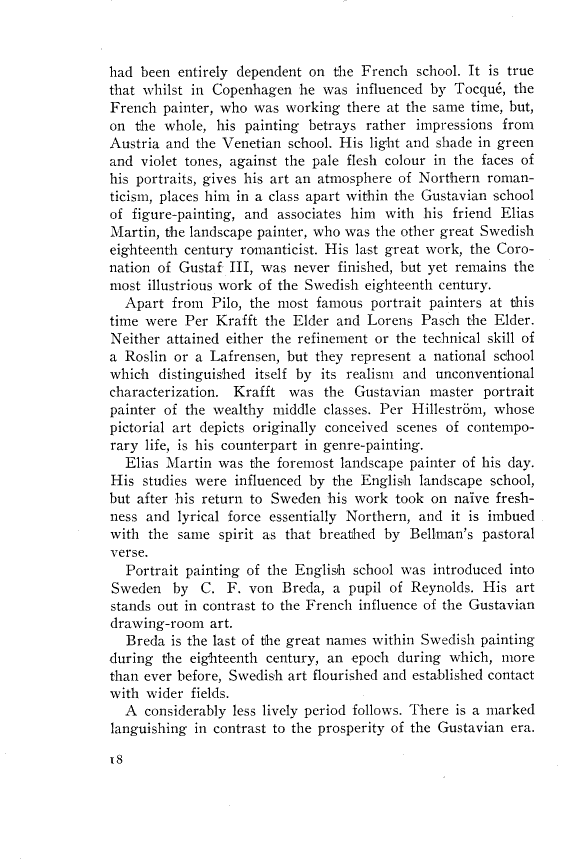
Full resolution (TIFF) - On this page / på denna sida - A short survey of the development of Swedish painting

<< prev. page << föreg. sida << >> nästa sida >> next page >>
Below is the raw OCR text
from the above scanned image.
Do you see an error? Proofread the page now!
Här nedan syns maskintolkade texten från faksimilbilden ovan.
Ser du något fel? Korrekturläs sidan nu!
This page has never been proofread. / Denna sida har aldrig korrekturlästs.
had been entirely dependent on the French school. It is true
that whilst in Copenhagen he was influenced by Tocqué, the
French painter, who was working there at the same time, but,
on the whole, his painting betrays rather impressions from
Austria and the Venetian school. His light and shade in green
and violet tones, against the pale flesh colour in the faces of
his portraits, gives his art an atmosphere of Northern
romanticism, places him in a class apart within the Gustavian school
of figure-painting, and associates him with his friend Elias
Martin, the landscape painter, who was the other great Swedish
eighteenth century romanticist. His last great work, the
Coronation of Gustaf III, was never finished, but yet remains the
most illustrious work of the Swedish eighteenth century.
Apart from Pilo, the most famous portrait painters at this
time were Per Krafft the Elder and Lorens Pasch the Elder.
Neither attained either the refinement or the technical skill of
a Roslin or a Lafrensen, but they represent a national school
which distinguished itself by its realism and unconventional
characterization. Krafft was the Gustavian master portrait
painter of the wealthy middle classes. Per Hilleström, whose
pictorial art depicts originally conceived scenes of
contemporary life, is his counterpart in genre-painting.
Elias Martin was the foremost landscape painter of his day.
His studies were influenced by the English landscape school,
but after his return to Sweden his work took on naïve
freshness and lyrical force essentially Northern, and it is imbued
with the same spirit as that breathed by Bellman’s pastoral
verse.
Portrait painting of the English school was introduced into
Sweden by C. F. von Breda, a pupil of Reynolds. His art
stands out in contrast to the French influence of the Gustavian
drawing-room art.
Breda is the last of the great names within Swedish painting
during the eighteenth century, an epoch during which, more
than ever before, Swedish art flourished and established contact
with wider fields.
A considerably less lively period follows. There is a marked
languishing in contrast to the prosperity of the Gustavian era.
t 8
<< prev. page << föreg. sida << >> nästa sida >> next page >>